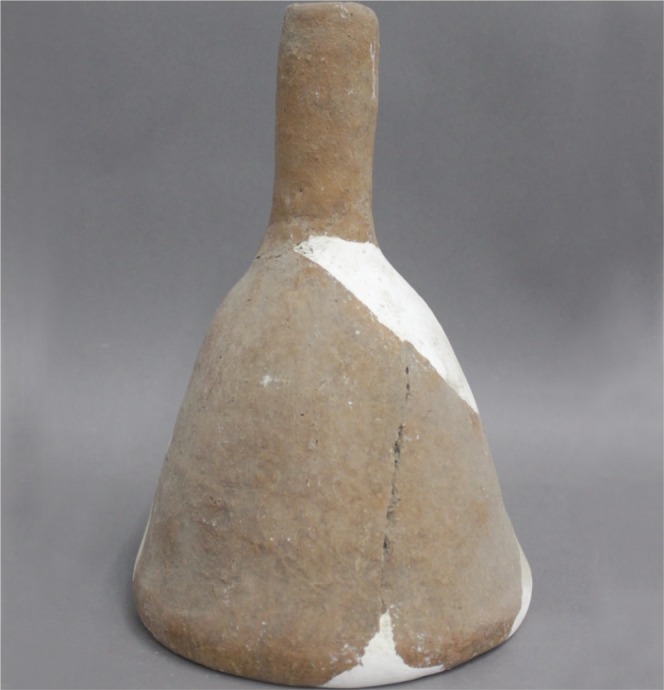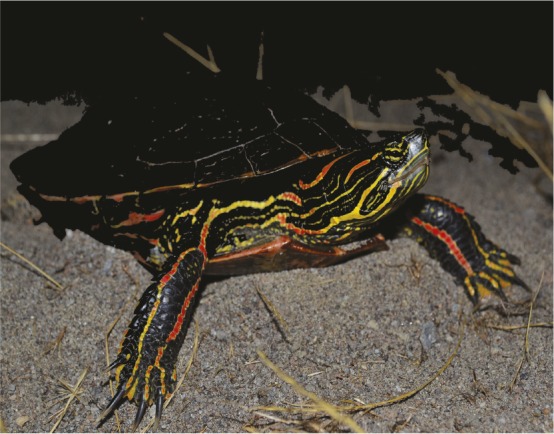Beer brewing in ancient China

Funnel for beer making from Mijiaya.
The time of onset of beer brewing in ancient China remains unclear. Jiajing Wang et al. (pp. 6444–6448) report the discovery of brewing artifacts in two pits dated to around 3400–2900 BC and unearthed at Mijiaya, an archaeological site near a tributary of the Wei River in northern China. Yellowish remnants found in wide-mouth pots, funnels, and amphorae suggest that the vessels were used for beer brewing, filtration, and storage. Stoves found in the pits likely provided heat for mashing grains. Morphological analysis of starch grains and phytoliths found inside the artifacts revealed broomcorn millets, barley, Job’s tears, and tubers; some starch grains bore marks reminiscent of malting and mashing. The presence of oxalate, a byproduct of beer brewing that was identified using ion chromatography, in some of the artifacts further supported their use as brewing vessels. Together, the lines of evidence suggest that the Yangshao people may have concocted a 5,000-year-old beer recipe that ushered the cultural practice of beer brewing into ancient China. According to the authors, the identification of barley residues in the Mijiaya artifacts represents the earliest known occurrence of barley in China, pushing back the crop’s advent in the country by approximately 1,000 years and suggesting that the crop may have been used as a beer-making ingredient long before it became a familiar agricultural staple. — P.N.
Senescence in turtles

Adult female painted turtle (Chrysemys picta). Image courtesy of David Delaney (Iowa State University, Ames, IA).
Senescence, which is marked by declining reproduction and increasing mortality with age, is commonly thought not to occur in various reptile species, particularly turtles. These species continue to grow throughout their lives, and their reproductive capacity typically increases with age. Hence, natural selection is thought to favor individuals that remain reproductively active with increasing age. To test this hypothesis, Daniel Warner et al. (pp. 6502–6507) gathered birth, death, and reproductive data for more than 1,000 painted turtles from northwest Illinois over a period of 24 years. The authors found that whereas total egg output tended to increase with age, the probability of successful hatching declined with age. Thus, contrary to expectations, overall reproductive fitness declined with increasing age. Mortality was also found to increase with age, with the mortality rate estimated to double every 13.8 years. The results suggest that senescence occurs in turtles, albeit at a slower rate than that observed in many mammals. The authors note that the population of turtles studied has a history of human-driven mortality. According to the authors, the extrinsic source of mortality might have driven selection for maximum reproductive fitness at an early age. — B.D.
Skeletal differences between Neandertal and modern human infants

Le Moustier lower rock shelter in France, where a Neandertal neonatal skeleton was found.
Neandertals differ from modern humans in skeletal features. Though many differences between Neandertal and modern human skulls exist at birth, the presence of differences in the rest of the body remains uncertain. Timothy Weaver et al. (pp. 6472–6477) measured the lengths and widths of the arm, leg, and pelvic bones from the two most complete Neandertal neonate skeletons from Russia and France. The authors compared the skeletons’ features with those from a sample of recent African- and European-American fetal skeletons from the National Museum of Natural History in Washington, DC. Compared with the recent human specimens, the Neandertal specimens had large hips relative to the length of the thigh bones, indicative of a wide body. The Neandertal from Russia had a longer pubis relative to the size of the hips than modern humans, and the ends of the Neandertals’ long bones were wider relative to their length than in modern humans. The differences between Neandertal and modern human neonate skeletons are similar to the differences between Neandertal and modern human adult skeletons. The results suggest that most skeletal differences between Neandertals and humans are established at birth, according to the authors. — B.D.
Snail abundance and parasitic disease spread
Schistosomiasis is a disease that affects around 150 million people in sub-Saharan Africa each year. The water-based, parasitic disease is caused by helminth worms, which mature and multiply in aquatic snails before infecting humans. Because snail abundance influences disease transmission, Javier Perez-Saez et al. (pp. 6427–6432) combined experimental and theoretical approaches to characterize the dynamics of snail populations found in a broad range of natural and artificial water habitats in Burkina Faso, a schistosomiasis-endemic West African country. The authors observed that population dynamics were controlled by negative feedback mechanisms, but the strength of this effect depended on the habitat type, snail species, and hydrologic conditions. For example, negative density feedbacks were strong in ephemeral streams but weak in perennial streams. Next, the authors ranked a large number of theoretical models of population dynamics based on their suitability for explaining the field observations of snail abundance. Statistical methods based on averaging the top 500 models were capable of providing reliable projections of snail abundance. Taken together, the findings highlight the importance of tailoring snail control measures to local ecological conditions, and provide a framework for forecasting snail population fluctuations based on habitat type and dominant hydrologic features. According to the authors, the findings could help improve the success of interventions aimed at decreasing schistosomiasis transmission. — J.W.
Modeling epidemics using mobile phone call data

Mobile phone call data provide information on population movement that may help in understanding disease outbreaks. Image courtesy of Flickr/Erik Hersman.
Mobile phone data permit the tracking of cell phone users’ movements, thus providing a rich source of information on population mobility, which is an important driver of infectious disease dynamics. Flavio Finger et al. (pp. 6421–6426) estimated daily population fluxes in Senegal using anonymized mobile phone records of 150,000 random users tracked throughout the year 2013. These population fluxes were incorporated into an epidemiological model of the 2005 Senegal cholera outbreak. The mobile phone data indicated that during a religious pilgrimage called the Grand Magal de Touba (GMdT), the population of the Diourbel region, where the GMdT takes place, temporarily swelled to nearly 6 times the number of year-round residents. In 2005, the GMdT coincided with a spike in the number of cholera cases in the same region. Using mobile phone data, the authors’ model accurately reproduced this spike and the subsequent spread of cholera throughout the country. The model also predicted that localized interventions to reduce disease transmission during the GMdT would have significantly reduced the number of cholera cases throughout the country. According to the authors, the results highlight the importance of mass gatherings as hotspots for disease progression and illustrate the usefulness of mobile phone data for identifying such hotspots and implementing control strategies. — B.D.
Dendrites and neuron–glia communication
Glial cells influence brain activity by releasing molecules that activate NMDA receptors (NMDARs) found on the surface of neurons, thereby triggering slow inward currents in neurons. However, the bulk of research on NMDAR-dependent slow inward currents has focused on the cell body rather than neuronal projections called dendrites, which help integrate signals from multiple cells and process information in the brain. Sufyan Ashhad and Rishikesh Narayanan (pp. E3280–E3289) used electrophysiological and pharmacological techniques to examine slow excitatory potentials, the voltage responses to slow inward currents in the cell bodies and dendrites of neurons in brain slices from the rat hippocampus. The authors found that the majority of NMDAR-dependent slow excitatory potentials originated in dendrites rather than the cell body. The magnitude and time course of slow excitatory potentials in dendrites were regulated by voltage-gated ion channels, which compartmentalized the spread of slow excitatory potentials within specific segments of the dendritic arbor. According to the authors, the findings reveal mechanisms by which slow excitatory potentials could generate localized neuronal responses that distinguish between the activation of different glial cells, thereby enhancing the neuron’s information processing capacity. Further, the study demonstrates that dendrites and their voltage-gated ion channels play an active role in regulating neuron–glia communication and network plasticity. — J.W.
Root-to-root communication and intercrop overyields

Faba bean/maize intercropping in China.
Humans have practiced intercropping for thousands of years; for example, maize, legumes, and squash are grown in the same field to boost the yield of all three crops. Although cereal/legume intercropping has been widely studied, why only certain combinations of plants produce overyields remains unclear. Bai Li et al. (pp. 6496–6501) performed field and greenhouse experiments that indicate that root-to-root interactions between faba bean and maize enhance faba bean nodulation, symbiotic nitrogen fixation, and productivity. Unlike wheat and barley, maize roots exude signaling compounds that double the production of chemical metabolites called flavonoids. These metabolites trigger a signaling cascade that allows symbiotic soil bacteria to enter legume roots and form nodules, which are production hubs where the bacteria convert atmospheric nitrogen into essential amino acids. The authors demonstrate that maize root exudates sharply upregulate the activity of a key enzyme in faba bean involved in flavonoid synthesis as well as the expression of several genes that mediate nodulation and plant hormonal responses. The findings reveal a mechanism that facilitates root interactions between intercropped species and offer insight into the ecosystem benefits of plant diversity, according to the authors. — T.J.


